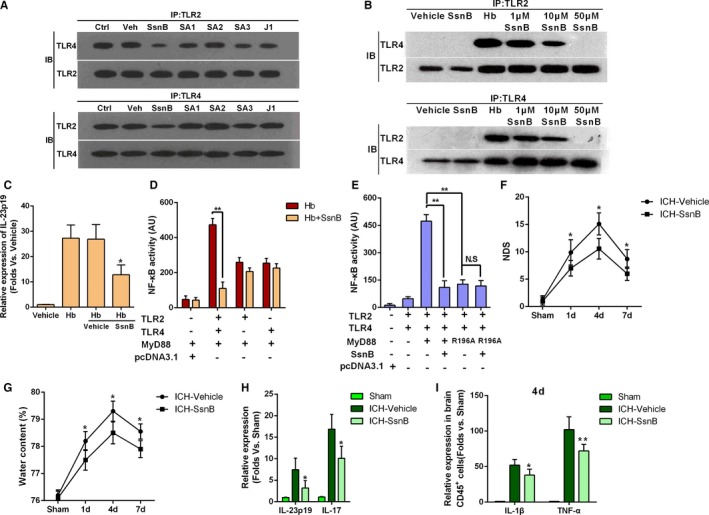Figure 7.

Sparstolonin B (SsnB) ameliorated intracerebral hemorrhage (ICH)–induced secondary injury by disrupting toll‐like receptor (TLR) 2/4 heterodimer formation. A, Coimmunoprecipitation of compounds derived from SsnB/J1 in cultured bone marrow–derived dendritic cells (BMDCs) exposed to 5 μmol/L hemoglobin (Hb; Ctrl) or Hb+vehicle/SsnB/one (all at 10 μmol/L) (with Ctrl indicating control only treated with Hb; Veh, Hb+ vehicle; IP, immunoprecipitation; IB, immunoblotting; n=5). B, IP of TLR2/TLR4 heterodimer in cultured BMDCs treated with Hb (5 μmol/L), SsnB (10 μmol/L), and Hb (5 μmol/L)+SsnB (1, 10, 20 μmol/L) (n=4). C, Interleukin (IL)‐23p19 mRNA expression in cultured Hb‐activated BMDCs treated with vehicle and SsnB (10 μmol/L). *P<0.05 vs Hb+vehicle, n=3. D, Nuclear factor‐κB (NF‐κB) activity in human embryonic kidney (HEK)‐293 cells treated with Hb and SsnB with or without TLR2 and TLR4 expression. **P<0.01, n=5. E, Effect of SsnB on Hb‐induced NF‐κB activity in TLR2‐TLR4‐myeloid differentiation factor 88 (MyD88)–transfected HEK‐293 cells (R196A, N‐terminal domain mutation of MyD88). **P<0.01, NS=no significant difference, n=5. F, Neurologic deficit score (NDS) for SsnB‐treated and untreated WT mice after ICH at 1, 4, and 7 days after ICH. *P<0.05 vs vehicle, n=5. Two‐way ANOVA reported significant difference in main effects of treatments (P<0.05) but not of time points (P>0.05), there was no interaction between treatments and time points (P>0.05). G, Brain water content for SsnB‐treated and untreated WT mice after ICH at 1, 4, and 7 days after ICH. *P<0.05 vs vehicle, n=5. H, IL‐23p19 and IL‐17 mRNA expression in the hemorrhagic hemisphere of SsnB‐treated or untreated WT mice on day 4 after ICH (*P<0.05 vs ICH‐vehicle, n=5). I, IL‐1β and tumor necrosis factor‐α (TNF‐α) mRNA levels in infiltrating CD45+ cells on day 4 after ICH. *P<0.05, **P<0.01 vs vehicle, n=4.
